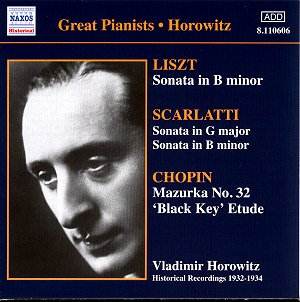It is an unaccustomedly gentle Horowitz who speaks
to us in the first of the Scarlatti sonatas, the poetical bell-like
tones of his piano far from anything Scarlatti would have known
but a wonderful re-creation in its own right. The nervous vitality
of the G major work is less unexpected but not the less marvellous
for that.
Though Horowitzís personality is stamped on every
bar of these performances, he does not obtain this result by waywardness.
Indeed, compared to most pianists of his day, and many of ours,
he is remarkably faithful to the written text. There is little
that an academic could take exception to in the Haydn sonata,
yet how he makes it speak! There were few takers for Haydnís piano
music in the 1930s, and Horowitz is as appreciative of his rococo
grace as he is of his extrovert fantasy, of his humour and of
his sheer bigness. He makes sure we know this music is important,
and it remains one of the few truly great performances of a Haydn
sonata on disc.
He distils an ineffable poetry from the Schumann
Arabesque and attains a clarity in Traumes Wirren
that most of us would despair of reaching at half the tempo. It
is very, very fast, but you donít feel (or I didnít) that he is
doing it to show off Ė he can still find time to make the music
speak.
The Chopin mazurkas are very fine, belonging
out in the fields as Rubinsteinís sat firmly in the salon. But
beware: they are extremely fast, as are, more reasonably, the
two studies. The c sharp minor seems a slightly dry technical
display but the poetry is back for the "Black Key Study".
Next we have a reminder that Horowitz had an eye open to composers
of his own day if they wrote colourfully and pianistically. It
is normal to consider the Debussy studies as slightly dry products
of his later years, less approachable than the Estampes, Images
and Préludes. Horowitz finds a translucent poetry
in no.11 that is quite beyond compare. He also finds the poetry
in Poulencís neo-classicism.
I have heard several versions of Rachmaninovís
Rimsky transcription in which the bumble-bee has seemed a pretty
bad-tempered old hornet. Here it has the grace of a butterfly;
maybe neither Rachmaninov or Rimsky-Korsakov intended this, but
its marvellous all the same. The Stravinsky is sometimes a little
too tumultuous for proper clarity, and we should remember that
Horowitz withdrew this record Ė only a few copies were made. We
should also remember that the Bumble-Bee and the Stravinsky share
a 78 side and so were played one after the other without a break
Ė and the Haydn and Poulenc were recorded on the same day!
The day after, Horowitz turned to the Liszt.
We are now accustomed to the idea that every pianist with a bit
of technique and a liking for romantic music wants to have a go
at the B minor sonata, but Horowitz was almost a prophet preaching
in the wilderness in 1932. As Jonathan Summersís notes tell us,
most critics back then were too busy savaging the music even to
notice the performance. Today we can recognise that Horowitzís
quite fantastic technical command is totally at the service of
the music whose grandeur and poetry is uniquely held in balance.
An indispensable performance.
Mark Obert-Thornís transfers make no attempt
to find a frequency range in these old recordings that they just
havenít got. The result is, within its limitations, pleasing to
the ear and reveals for us a Horowitz who, for all his fantastic
technical equipment, was always rounded of tone and deeply poetical
in his response to the music. We are used to hearing Horowitz
in later recordings that zoomed in on his phenomenal technical
address. But this technical address was intended for the public
at the back of a large hall, it was not intended to be listened
to close up. For all their limitations, these early recordings
may give a better idea of what audiences actually heard. We are
reminded that the piano remains the hardest of instruments to
record, and the pianists who sound best on disc tend to be those
who sound puny in the concert hall.
There are other transfers of this material around,
of course, including EMIís own, which bring together all the recordings
he made for them between 1931 and 1951 on 3 CDs. Presumably Naxos
will be issuing the remaining out-of-copyright material in due
course. This remains some of the most astounding piano playing
ever committed to disc and you should not be without it in one
form or another.
Rather as orchestras during rehearsals sometimes
play wrong notes on purpose to see if the conductor is competent
enough to notice, Naxos have set a few traps for napping critics.
An obvious one is that Vladimir Horowitz: HMV Recordings 1932-34
contains some from 1935. Another (duly picked up above) is
that they have shown a "wrong" mazurka Ė with its accompanying
"wrong" date Ė in the booklet and on the cover. I hope
I havenít got egg on my face by failing to spot any more.
Christopher Howell

